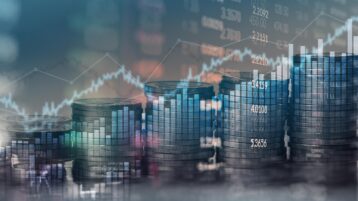The ongoing pandemic has helped highlight some of the shortcomings of global supply chains, especially involving automakers. Anthony Okolie speaks with Thomas Feltmate, Senior Economist, TD Bank, about steps car companies may have to take to avoid future disruptions.
Print Transcript
[AUDIO LOGO]
- Thomas, you wrote a great report on the supply bottlenecks that are impacting the global auto supply chains, which have also impacted auto production. But before we get into that, what are some of the other cyclical factors that are impacting overall production?
- Right, that's a great question. So if we look to the US, not only for the automotive sector in general, but just generally speaking, some of the supply constraints that we're seeing. If we look out to the West Coast, in particular the Port of Los Angeles and Long Beach, this accounts for about 40% of the annual freight that comes into the US on an annual basis.
Both ports have become incredibly backlogged right now. And in fact, they can't really move carriers and cargo out fast enough to accommodate the new ships to come in and bring more supply in. So this is causing an incredible amount of bottlenecks across the entire US supply chain.
Now just recently, we've seen the Biden administration take some pretty meaningful steps to try and alleviate these pressures. So we've seen the terminals allowed to open-- be open 24/7. So trucks can come and go to try and move increasingly more cargo out.
And we've also seen fines start to be levied on carriers for cargo that stays in port for more than nine days. So hopefully, you know, heading into the holiday season, this will certainly help to ease some of those supply pressures, get product out into warehouses and parts to assembly floors.
We also-- labor shortages have also become a big issue in the US. We look across all industries, with the exception of transportation and warehouse and finance, real estate, and insurance, all other industries are still below pre-pandemic levels when we're looking at employment activity today.
And of course, the manufacturing sector hasn't been immune to this. If we look at auto production and overall auto employment within the industry, we're still about 5% below pre-pandemic levels. So the combination of not necessarily being able to get parts to assembly floors, then when we do get them there, not having the right workers or enough workers to assemble the vehicles have also been some headwinds that the industry has faced.
- Now, you also identify the power crisis in China as another factor that could impact auto production, particularly next year. Why is that?
- Yeah, so this is an interesting risk that really bears close watching, I would say over the coming weeks and months. So what we've seen is back in September, in an effort to kind of curb energy consumption, the Chinese government has imposed pretty strict restrictions on magnesium production, which is highly energy intensive.
Now, this is important from the automotive sector for two main reasons. Magnesium is a key input that goes into the production of aluminum. And of course, as we know, aluminum is a key material that's used in the automotive assembly process.
And China also accounts for about 85% of the global magnesium supply. So any meaningful change in terms of annual production could certainly have pretty dire impacts on the market. Now thankfully, we have seen those restrictions kind of ease more recently.
But if we look at overall production levels today, we're still about 50% below kind of normal time. So unless we see a further easing in those restrictions over the coming weeks, months, it could have some pretty dire impacts when we look at auto production, particularly heading into 2022.
ANTHONY OKOLIE: OK, I want to get back to the supply chain issue again. Are we likely to see any changes in the way North American automakers manage their inventories or build their supply chains to fix these flaws in the supply chain?
- I think so, yeah. So if we kind of look at the standard framework that automakers have followed over the last several decades, it's been this kind of just-in-time inventory management framework, where basically, parts were being delivered to assembly floors hours, sometimes minutes before they were actually being used in the assembly process. Now obviously, this was hugely beneficial for automakers in the past several decades, when we didn't necessarily see any wrinkles within the supply chain.
Of course, we look over the past year, there's been a lot of issues. And that is certainly caused a lot of problems on the going forward basis. So I think if we look into the coming years, we're certainly going to see a rotation away from just kind of just-in-time management framework, to something that looks more like just-in-case-type model, where basically, we'll have parallel supply chain set up so automakers might continue to operate in this globally integrated supply chain if it proves to be economically beneficial to do so.
But they'll have a parallel supply chain set up operating in the background that they could easily pivot to in the case where there might be disruptions along the kind of primary operating supply chain. I think stockpiling too, of kind of some of the key input parts and materials that are deemed to be absolutely essential in the production process-- that could certainly happen too, on a going forward basis.
- And what about the growing EV market? We certainly see it in the headlines recently, with the Biden potential budget he's going to be signing, as well as Tesla and some of the other automakers in the news. How does North America compare to China and the EU when it comes to building our domestic supply chains and government incentives, as well as funding research and investment?
- Yeah, so this has been an interesting story, where it's definitely a case of demand kind of leads supply. And what we found so far in North America is we just haven't necessarily seen a strong uptake of EVs just yet. And if we look to consumer surveys, there's a few different reasons for this.
First and foremost, range anxiety still really is a big issue in the US, because charging infrastructure just hasn't developed to the rate that consumers need to see it in order to feel comfortable in purchasing EV. Consumer incentives are also playing a role too, where the existing incentives that are in place today are just not enough to offset that initial upfront cost that does come with purchasing an EV.
Now, as you've mentioned, we've seen some pretty meaningful developments just over the last month or so from the Biden administration. So through the infrastructure plan, $7 billion has been allocated to further enhance the US charging infrastructure over the next five-year period. So $7 billion equates to about 250,000 new charging stations over the next five years, which would represent about a five-fold increase from today's operating level, so a pretty meaningful move.
And while not necessarily passed yet, the spending bill that's currently being negotiated has allocated $555 billion for furthering consumer incentives. So this could take the individual federal consumer incentive from $7,500 up to $12,500. So again, a meaningful reduction in that entry-level price and should certainly go a long way in kind of broadening the consumer base a bit more.
I think the one area where we haven't necessarily seen a lot of intervention from the government is perhaps, financing automakers to go out and develop battery development plants and fund research projects on that side of things. But certainly, I think going forward, that's where we're going to see more of the initiatives kind of thing.
- So given all of this, what's your medium and long-term outlook for the auto sector going forward?
- Yeah, so I think certainly going into 2022, production is still going to be somewhat hindered, particularly in the first half of the year by the chip shortage. The hope right now is those pressures start to ease as we get into the second half of next year, and we kind of get back to operating levels that look kind of more like pre-pandemic production levels on a monthly basis.
And then certainly, heading into 2023, the hope is we're getting back to kind of pre-pandemic annual levels of production, so something in around 18 million units, which would certainly go a long way in bringing more inventory to the market and really kind of easing some of those constraints that we've seen on that side of things over the last year or so.
- Thomas, thank you very much for joining us.
- You bet. Thanks for having me.
[AUDIO LOGO]
[MUSIC PLAYING]
- Thomas, you wrote a great report on the supply bottlenecks that are impacting the global auto supply chains, which have also impacted auto production. But before we get into that, what are some of the other cyclical factors that are impacting overall production?
- Right, that's a great question. So if we look to the US, not only for the automotive sector in general, but just generally speaking, some of the supply constraints that we're seeing. If we look out to the West Coast, in particular the Port of Los Angeles and Long Beach, this accounts for about 40% of the annual freight that comes into the US on an annual basis.
Both ports have become incredibly backlogged right now. And in fact, they can't really move carriers and cargo out fast enough to accommodate the new ships to come in and bring more supply in. So this is causing an incredible amount of bottlenecks across the entire US supply chain.
Now just recently, we've seen the Biden administration take some pretty meaningful steps to try and alleviate these pressures. So we've seen the terminals allowed to open-- be open 24/7. So trucks can come and go to try and move increasingly more cargo out.
And we've also seen fines start to be levied on carriers for cargo that stays in port for more than nine days. So hopefully, you know, heading into the holiday season, this will certainly help to ease some of those supply pressures, get product out into warehouses and parts to assembly floors.
We also-- labor shortages have also become a big issue in the US. We look across all industries, with the exception of transportation and warehouse and finance, real estate, and insurance, all other industries are still below pre-pandemic levels when we're looking at employment activity today.
And of course, the manufacturing sector hasn't been immune to this. If we look at auto production and overall auto employment within the industry, we're still about 5% below pre-pandemic levels. So the combination of not necessarily being able to get parts to assembly floors, then when we do get them there, not having the right workers or enough workers to assemble the vehicles have also been some headwinds that the industry has faced.
- Now, you also identify the power crisis in China as another factor that could impact auto production, particularly next year. Why is that?
- Yeah, so this is an interesting risk that really bears close watching, I would say over the coming weeks and months. So what we've seen is back in September, in an effort to kind of curb energy consumption, the Chinese government has imposed pretty strict restrictions on magnesium production, which is highly energy intensive.
Now, this is important from the automotive sector for two main reasons. Magnesium is a key input that goes into the production of aluminum. And of course, as we know, aluminum is a key material that's used in the automotive assembly process.
And China also accounts for about 85% of the global magnesium supply. So any meaningful change in terms of annual production could certainly have pretty dire impacts on the market. Now thankfully, we have seen those restrictions kind of ease more recently.
But if we look at overall production levels today, we're still about 50% below kind of normal time. So unless we see a further easing in those restrictions over the coming weeks, months, it could have some pretty dire impacts when we look at auto production, particularly heading into 2022.
ANTHONY OKOLIE: OK, I want to get back to the supply chain issue again. Are we likely to see any changes in the way North American automakers manage their inventories or build their supply chains to fix these flaws in the supply chain?
- I think so, yeah. So if we kind of look at the standard framework that automakers have followed over the last several decades, it's been this kind of just-in-time inventory management framework, where basically, parts were being delivered to assembly floors hours, sometimes minutes before they were actually being used in the assembly process. Now obviously, this was hugely beneficial for automakers in the past several decades, when we didn't necessarily see any wrinkles within the supply chain.
Of course, we look over the past year, there's been a lot of issues. And that is certainly caused a lot of problems on the going forward basis. So I think if we look into the coming years, we're certainly going to see a rotation away from just kind of just-in-time management framework, to something that looks more like just-in-case-type model, where basically, we'll have parallel supply chain set up so automakers might continue to operate in this globally integrated supply chain if it proves to be economically beneficial to do so.
But they'll have a parallel supply chain set up operating in the background that they could easily pivot to in the case where there might be disruptions along the kind of primary operating supply chain. I think stockpiling too, of kind of some of the key input parts and materials that are deemed to be absolutely essential in the production process-- that could certainly happen too, on a going forward basis.
- And what about the growing EV market? We certainly see it in the headlines recently, with the Biden potential budget he's going to be signing, as well as Tesla and some of the other automakers in the news. How does North America compare to China and the EU when it comes to building our domestic supply chains and government incentives, as well as funding research and investment?
- Yeah, so this has been an interesting story, where it's definitely a case of demand kind of leads supply. And what we found so far in North America is we just haven't necessarily seen a strong uptake of EVs just yet. And if we look to consumer surveys, there's a few different reasons for this.
First and foremost, range anxiety still really is a big issue in the US, because charging infrastructure just hasn't developed to the rate that consumers need to see it in order to feel comfortable in purchasing EV. Consumer incentives are also playing a role too, where the existing incentives that are in place today are just not enough to offset that initial upfront cost that does come with purchasing an EV.
Now, as you've mentioned, we've seen some pretty meaningful developments just over the last month or so from the Biden administration. So through the infrastructure plan, $7 billion has been allocated to further enhance the US charging infrastructure over the next five-year period. So $7 billion equates to about 250,000 new charging stations over the next five years, which would represent about a five-fold increase from today's operating level, so a pretty meaningful move.
And while not necessarily passed yet, the spending bill that's currently being negotiated has allocated $555 billion for furthering consumer incentives. So this could take the individual federal consumer incentive from $7,500 up to $12,500. So again, a meaningful reduction in that entry-level price and should certainly go a long way in kind of broadening the consumer base a bit more.
I think the one area where we haven't necessarily seen a lot of intervention from the government is perhaps, financing automakers to go out and develop battery development plants and fund research projects on that side of things. But certainly, I think going forward, that's where we're going to see more of the initiatives kind of thing.
- So given all of this, what's your medium and long-term outlook for the auto sector going forward?
- Yeah, so I think certainly going into 2022, production is still going to be somewhat hindered, particularly in the first half of the year by the chip shortage. The hope right now is those pressures start to ease as we get into the second half of next year, and we kind of get back to operating levels that look kind of more like pre-pandemic production levels on a monthly basis.
And then certainly, heading into 2023, the hope is we're getting back to kind of pre-pandemic annual levels of production, so something in around 18 million units, which would certainly go a long way in bringing more inventory to the market and really kind of easing some of those constraints that we've seen on that side of things over the last year or so.
- Thomas, thank you very much for joining us.
- You bet. Thanks for having me.
[AUDIO LOGO]
[MUSIC PLAYING]



























